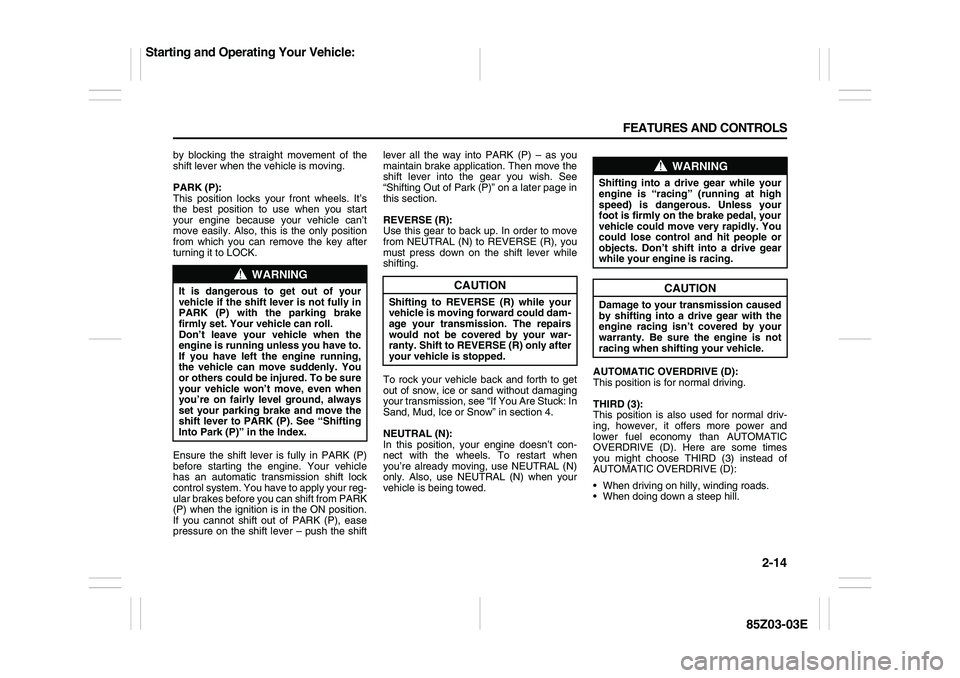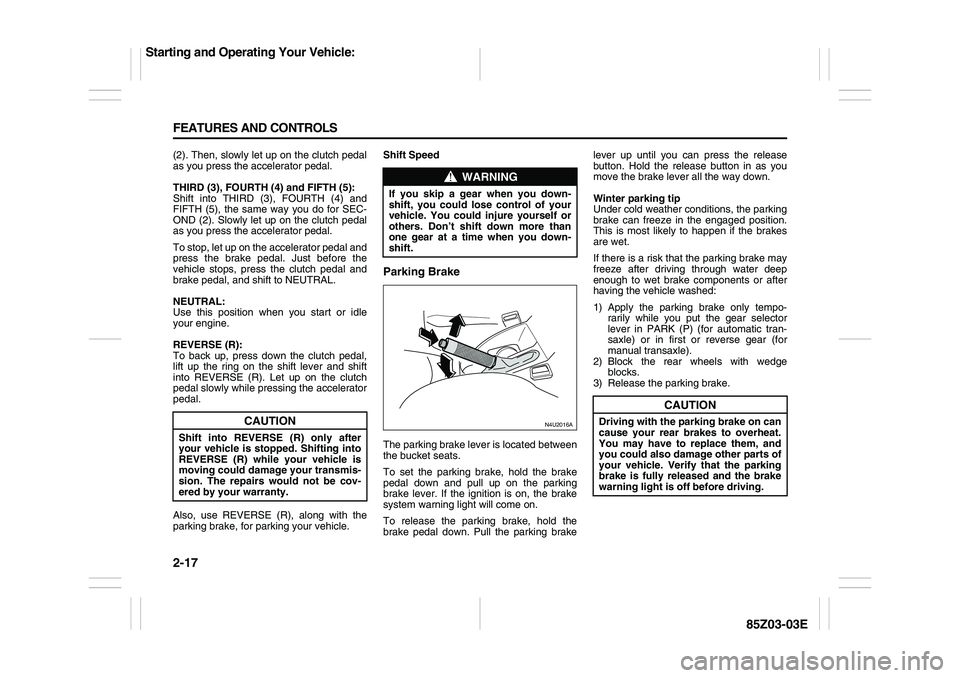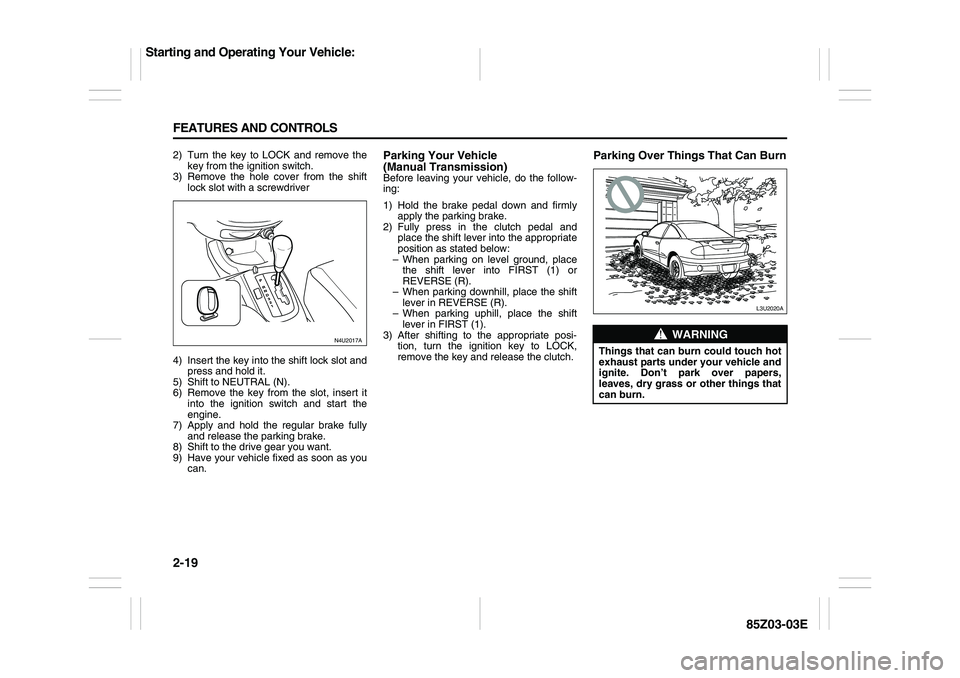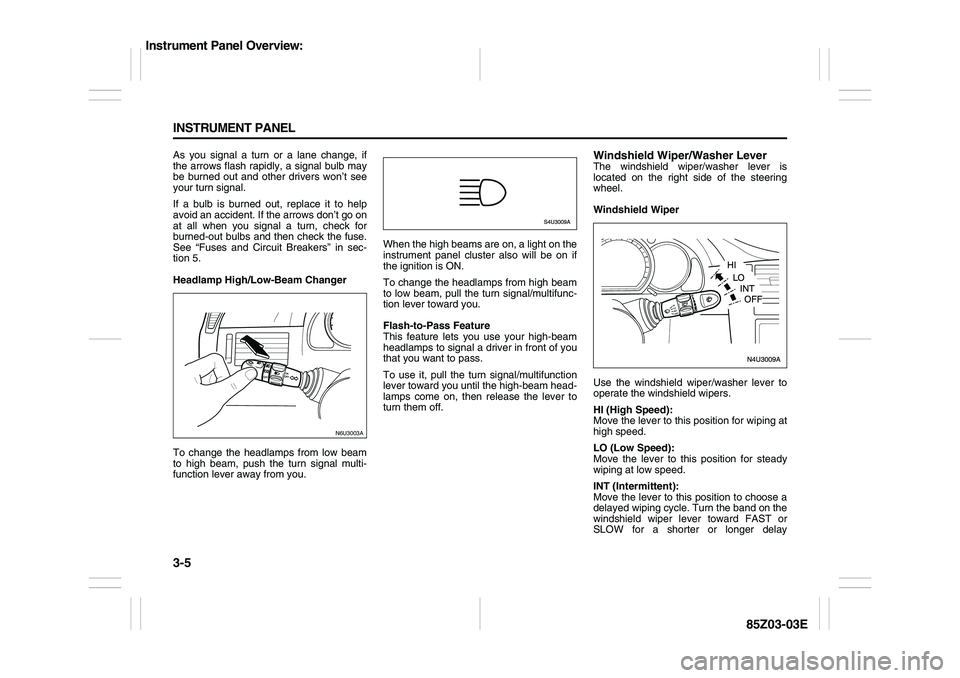2007 SUZUKI FORENZA ignition
[x] Cancel search: ignitionPage 61 of 225

2-13 FEATURES AND CONTROLS
85Z03-03E
Starting Your EngineAutomatic Transmission
Move your shift lever to PARK (P) or NEU-
TRAL (N). Your engine won’t start in any
other position – that’s a safety feature. To
restart when you’re already moving, use
NEUTRAL (N) only.
Manual Transmission
The gear selector should be in NEUTRAL
and the parking brake engaged. Hold the
clutch pedal to the floor and start the
engine. Your vehicle won’t start if the clutch
pedal is not all the way down.
Starting Your Engine
1) With your foot off the accelerator pedal,
turn your ignition key to START. When
the engine starts, let go of the key. The
idle speed will go down as your engine
gets warm.2) If it doesn’t start, wait about 15 seconds
and try again to start the engine by
turning the ignition key to START. Wait
about 15 seconds between each try.
When your engine has run about 10
seconds to warm up, your vehicle is
ready to be driven. Don’t “race” your
engine when it’s cold. If the weather is
below freezing (32°F or 0°C), let the
engine run for a few minutes to warm
up.
3) If your engine still won’t start (or starts
but then stops), it could be flooded with
too much gasoline. Try pushing your
accelerator pedal all the way to the floor
and holding it there as you hold the key
in START for about three seconds. If
the vehicle starts briefly but then stops
again, do the same thing, but this time
keep the pedal down for five or six sec-
onds. This clears the extra gasoline
from the engine.
Automatic Transmission OperationIf your vehicle is equipped with an auto-
matic transmission, the shift lever is
located on the console between the seats.
Movement between certain positions
requires pushing the shift lever to the pas-
senger side while shifting. This prevents
you from changing positions unexpectedly
CAUTION
Don’t try to shift to PARK (P) if your
vehicle is moving. If you do, you
could damage the transmission. Shift
to PARK (P) only when your vehicle is
stopped.
CAUTION
Holding your key in START for longer
than 15 seconds at a time will cause
your battery to be drained much
sooner. And the excessive heat can
damage your starter motor. Wait
about 15 seconds between each try
to help avoid draining your battery or
damaging your starter.
CAUTION
Your engine is designed to work with
the electronics in your vehicle. If you
add electrical parts or accessories,
you could change the way the engine
operates. Before adding electrical
equipment, check with your SUZUKI
dealer. If you don’t, your engine
might not perform properly.
N4U2014A
H
O
L
D
Starting and Operating Your Vehicle:
Page 62 of 225

2-14 FEATURES AND CONTROLS
85Z03-03E
by blocking the straight movement of the
shift lever when the vehicle is moving.
PARK (P):
This position locks your front wheels. It’s
the best position to use when you start
your engine because your vehicle can’t
move easily. Also, this is the only position
from which you can remove the key after
turning it to LOCK.
Ensure the shift lever is fully in PARK (P)
before starting the engine. Your vehicle
has an automatic transmission shift lock
control system. You have to apply your reg-
ular brakes before you can shift from PARK
(P) when the ignition is in the ON position.
If you cannot shift out of PARK (P), ease
pressure on the shift lever – push the shiftlever all the way into PARK (P) – as you
maintain brake application. Then move the
shift lever into the gear you wish. See
“Shifting Out of Park (P)” on a later page in
this section.
REVERSE (R):
Use this gear to back up. In order to move
from NEUTRAL (N) to REVERSE (R), you
must press down on the shift lever while
shifting.
To rock your vehicle back and forth to get
out of snow, ice or sand without damaging
your transmission, see “If You Are Stuck: In
Sand, Mud, Ice or Snow” in section 4.
NEUTRAL (N):
In this position, your engine doesn’t con-
nect with the wheels. To restart when
you’re already moving, use NEUTRAL (N)
only. Also, use NEUTRAL (N) when your
vehicle is being towed.AUTOMATIC OVERDRIVE (D):
This position is for normal driving.
THIRD (3):
This position is also used for normal driv-
ing, however, it offers more power and
lower fuel economy than AUTOMATIC
OVERDRIVE (D). Here are some times
you might choose THIRD (3) instead of
AUTOMATIC OVERDRIVE (D):
When driving on hilly, winding roads.
When doing down a steep hill.
WARNING
It is dangerous to get out of your
vehicle if the shift lever is not fully in
PARK (P) with the parking brake
firmly set. Your vehicle can roll.
Don’t leave your vehicle when the
engine is running unless you have to.
If you have left the engine running,
the vehicle can move suddenly. You
or others could be injured. To be sure
your vehicle won’t move, even when
you’re on fairly level ground, always
set your parking brake and move the
shift lever to PARK (P). See “Shifting
Into Park (P)” in the Index.
CAUTION
Shifting to REVERSE (R) while your
vehicle is moving forward could dam-
age your transmission. The repairs
would not be covered by your war-
ranty. Shift to REVERSE (R) only after
your vehicle is stopped.
WARNING
Shifting into a drive gear while your
engine is “racing” (running at high
speed) is dangerous. Unless your
foot is firmly on the brake pedal, your
vehicle could move very rapidly. You
could lose control and hit people or
objects. Don’t shift into a drive gear
while your engine is racing.
CAUTION
Damage to your transmission caused
by shifting into a drive gear with the
engine racing isn’t covered by your
warranty. Be sure the engine is not
racing when shifting your vehicle.
Starting and Operating Your Vehicle:
Page 65 of 225

2-17 FEATURES AND CONTROLS
85Z03-03E
(2). Then, slowly let up on the clutch pedal
as you press the accelerator pedal.
THIRD (3), FOURTH (4) and FIFTH (5):
Shift into THIRD (3), FOURTH (4) and
FIFTH (5), the same way you do for SEC-
OND (2). Slowly let up on the clutch pedal
as you press the accelerator pedal.
To stop, let up on the accelerator pedal and
press the brake pedal. Just before the
vehicle stops, press the clutch pedal and
brake pedal, and shift to NEUTRAL.
NEUTRAL:
Use this position when you start or idle
your engine.
REVERSE (R):
To back up, press down the clutch pedal,
lift up the ring on the shift lever and shift
into REVERSE (R). Let up on the clutch
pedal slowly while pressing the accelerator
pedal.
Also, use REVERSE (R), along with the
parking brake, for parking your vehicle.Shift Speed
Parking BrakeThe parking brake lever is located between
the bucket seats.
To set the parking brake, hold the brake
pedal down and pull up on the parking
brake lever. If the ignition is on, the brake
system warning light will come on.
To release the parking brake, hold the
brake pedal down. Pull the parking brakelever up until you can press the release
button. Hold the release button in as you
move the brake lever all the way down.
Winter parking tip
Under cold weather conditions, the parking
brake can freeze in the engaged position.
This is most likely to happen if the brakes
are wet.
If there is a risk that the parking brake may
freeze after driving through water deep
enough to wet brake components or after
having the vehicle washed:
1) Apply the parking brake only tempo-
rarily while you put the gear selector
lever in PARK (P) (for automatic tran-
saxle) or in first or reverse gear (for
manual transaxle).
2) Block the rear wheels with wedge
blocks.
3) Release the parking brake.
CAUTION
Shift into REVERSE (R) only after
your vehicle is stopped. Shifting into
REVERSE (R) while your vehicle is
moving could damage your transmis-
sion. The repairs would not be cov-
ered by your warranty.
WARNING
If you skip a gear when you down-
shift, you could lose control of your
vehicle. You could injure yourself or
others. Don’t shift down more than
one gear at a time when you down-
shift.
N4U2016A
CAUTION
Driving with the parking brake on can
cause your rear brakes to overheat.
You may have to replace them, and
you could also damage other parts of
your vehicle. Verify that the parking
brake is fully released and the brake
warning light is off before driving.
Starting and Operating Your Vehicle:
Page 66 of 225

2-18 FEATURES AND CONTROLS
85Z03-03E
Shifting Into Park (P)
(Automatic Transmission)1) Hold the brake pedal down and set the
parking brake.
2) Move the shift lever into PARK (P) posi-
tion.
3) Turn the ignition key to LOCK.
4) Remove the key and take it with you. If
you can leave your vehicle with the igni-
tion key in your hand, your vehicle is in
PARK (P).Leaving Your Vehicle with the Engine
Running
If you have to leave your vehicle with the
engine running, be sure your vehicle is in
PARK (P) and your parking brake is firmly
set before you leave it. After you’ve moved
the shift lever into PARK (P), hold the regu-
lar brake pedal down. Then, see if you can
move the shift lever away from PARK (P)
without first pushing the button. If you can,
it means that the shift lever wasn’t fully
locked into PARK (P).Torque Lock
If you are parking on a hill and you don’t
shift your transmission into PARK (P) prop-
erly, the weight of the vehicle may put too
much force on the parking pawl in the
transmission. You may find it difficult to pull
the shift lever out of PARK (P). This is
called “torque lock.” To prevent torque lock,
set the parking brake and then shift into
PARK (P) properly before you leave the
driver’s seat. To find out how, see “Shifting
Into Park (P)” in this section.
When you are ready to drive, move the
shift lever out of PARK (P) before you
release the parking brake.
If torque lock does occur, you may need to
have another vehicle push yours a little
uphill to take some of the pressure from
the parking pawl in the transmission, so
you can pull the shift lever out of PARK (P).
Shifting Out of Park (P)
(Automatic Transmission)Your vehicle has a brake transmission shift
interlock system which locks the shift lever
in PARK (P) when the ignition is in the
LOCK position. You have to apply your reg-
ular brakes before you can shift from PARK
(P) when the ignition is in the ON position.
See “Automatic Transmission Operation” in
this section.
If you cannot shift out of PARK (P) while
you hold the brake pedal down, try this:
1) Set the parking brake fully.
WARNING
It is dangerous to get out of your
vehicle if the shift lever is not fully in
PARK (P) with the parking brake
firmly set. Your vehicle can roll. Don’t
leave your vehicle when the engine is
running unless you have to. If you
have left the engine running, the
vehicle can move suddenly. You or
others could be injured. To be sure
your vehicle won’t move, even when
you’re on fairly level ground, use the
steps that follow.
WARNING
It can be dangerous to leave your
vehicle with the engine running. Your
vehicle could move suddenly if the
shift lever is not fully in PARK (P)
with the parking brake firmly set.
And, if you leave the vehicle with the
engine running, it could overheat and
even catch fire. You or others could
be injured. Don’t leave your vehicle
with the engine running.
Starting and Operating Your Vehicle:
Page 67 of 225

2-19 FEATURES AND CONTROLS
85Z03-03E
2) Turn the key to LOCK and remove the
key from the ignition switch.
3) Remove the hole cover from the shift
lock slot with a screwdriver
4) Insert the key into the shift lock slot and
press and hold it.
5) Shift to NEUTRAL (N).
6) Remove the key from the slot, insert it
into the ignition switch and start the
engine.
7) Apply and hold the regular brake fully
and release the parking brake.
8) Shift to the drive gear you want.
9) Have your vehicle fixed as soon as you
can.
Parking Your Vehicle
(Manual Transmission)Before leaving your vehicle, do the follow-
ing:
1) Hold the brake pedal down and firmly
apply the parking brake.
2) Fully press in the clutch pedal and
place the shift lever into the appropriate
position as stated below:
– When parking on level ground, place
the shift lever into FIRST (1) or
REVERSE (R).
– When parking downhill, place the shift
lever in REVERSE (R).
– When parking uphill, place the shift
lever in FIRST (1).
3) After shifting to the appropriate posi-
tion, turn the ignition key to LOCK,
remove the key and release the clutch.
Parking Over Things That Can Burn
N4U2017A
WARNING
Things that can burn could touch hot
exhaust parts under your vehicle and
ignite. Don’t park over papers,
leaves, dry grass or other things that
can burn.
L3U2020A
Starting and Operating Your Vehicle:
Page 69 of 225

2-21 FEATURES AND CONTROLS
85Z03-03E
MirrorsManual Rearview MirrorWhen you are sitting in a comfortable driv-
ing position, adjust the mirror so you can
see clearly behind your vehicle. Grip the
mirror in the center to move it up or down
and from side to side.
The day/night adjustment allows you to
adjust the mirror to avoid glare from any
headlamps behind you. Push or pull the
tab for daytime/night use.
Outside Manual MirrorThe outside rearview mirrors should be
adjusted so you can see a little of the side
of your vehicle when you are sitting in a
comfortable driving position.
Adjust the outside mirrors with the control
levers on the driver’s and passenger’s
doors.
The outside rearview mirrors can be folded
flat against the side of the vehicle by push-
ing them toward the vehicle.
Outside Power MirrorsIf your vehicle has this feature, the control
for the power mirrors is located on the
driver’s side door trim.
Move the outside power mirror control to
“L” to adjust the left mirror and to “R” to
adjust the right mirror. If you place the con-
trol in the center position, no movement of
the mirror will occur. To adjust a mirror,
press the corresponding edges located on
the four-way control pad to move the mirror
in the direction that you want it to go. The
ignition must be to ON to adjust the mir-
rors.
The outside rearview mirrors can be folded
flat against the side of the vehicle by push-
ing them toward the vehicle.
L3U2021A
N4U2018A
N4U2019A
Mirrors:
Page 74 of 225

2-26 FEATURES AND CONTROLS
85Z03-03E
windshield glass to avoid causing breaks in
the resistive material heating element
which can adversely affect radio and
defogger performance. See your SUZUKI
dealer for details.
SunroofIf your vehicle has this feature, the switch
is located between the map lamp buttons.
The sunroof will only operate when the
ignition is in the ON position. The sunroof
can be opened to a vent position or it can
be opened all the way.
You must manually open and close the
sunroof cover.
To open the sunroof to the vent position,
push the front part of the switch. To return
the sunroof to its original position, push the
rear part of the switch and hold it until the
sunroof reaches the desired position.
To fully open the sunroof, push the rear
part of the switch. The sunroof will open
automatically until you push either the front
or the rear part of the switch again. To
close the sunroof, push the front part of theswitch and hold it until the sunroof is
closed. The sunroof will stop if the switch is
released during operation.
In both the vent and fully open positions,
the air flow can be adjusted for driving
comfort by pushing and holding the switch
until the sunroof moves to the desired posi-
tion.
The sunroof glass panel cannot be opened
or closed if your vehicle has an electrical
failure.
N4U2024A
WARNING
Never allow any part of your body
such as hands or head to stick out
of the sunroof opening while the
vehicle is moving.
Be sure there are no hands or other
obstructions in the path of the sun-
roof when you close the sunroof.
Always remove the ignition key
when leaving the vehicle even if for
a short time. Also do not leave chil-
dren alone in a parked vehicle.
Unattended children could use the
sunroof switches and get trapped
by the sunroof.
Do not put your body weight on the
roof around the sunroof such as by
sitting on it.
When leaving the vehicle unat-
tended, close the sunroof fully.
Sunroof:
Page 81 of 225

3-5 INSTRUMENT PANEL
85Z03-03E
As you signal a turn or a lane change, if
the arrows flash rapidly, a signal bulb may
be burned out and other drivers won’t see
your turn signal.
If a bulb is burned out, replace it to help
avoid an accident. If the arrows don’t go on
at all when you signal a turn, check for
burned-out bulbs and then check the fuse.
See “Fuses and Circuit Breakers” in sec-
tion 5.
Headlamp High/Low-Beam Changer
To change the headlamps from low beam
to high beam, push the turn signal multi-
function lever away from you.When the high beams are on, a light on the
instrument panel cluster also will be on if
the ignition is ON.
To change the headlamps from high beam
to low beam, pull the turn signal/multifunc-
tion lever toward you.
Flash-to-Pass Feature
This feature lets you use your high-beam
headlamps to signal a driver in front of you
that you want to pass.
To use it, pull the turn signal/multifunction
lever toward you until the high-beam head-
lamps come on, then release the lever to
turn them off.
Windshield Wiper/Washer LeverThe windshield wiper/washer lever is
located on the right side of the steering
wheel.
Windshield Wiper
Use the windshield wiper/washer lever to
operate the windshield wipers.
HI (High Speed):
Move the lever to this position for wiping at
high speed.
LO (Low Speed):
Move the lever to this position for steady
wiping at low speed.
INT (Intermittent):
Move the lever to this position to choose a
delayed wiping cycle. Turn the band on the
windshield wiper lever toward FAST or
SLOW for a shorter or longer delay
N6U3003A
Instrument Panel Overview: